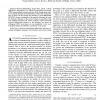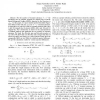45 search results - page 8 / 9 » Four-Group Decodable Space-Time Block Codes |
CORR
2007
Springer
13 years 7 months ago
2007
Springer
It is well known that Space-Time Block Codes (STBCs) obtained from Orthogonal Designs (ODs) are singlesymbol-decodable (SSD) and from Quasi-Orthogonal Designs (QODs) are double-sy...
TWC
2008
13 years 7 months ago
2008
Diversity-Embedding Space-Time Block Coding (DE-STBC), introduced in [1], enables Unequal Error Protection (UEP) using multiple transmit antennas. Even though these codes do not re...
ICC
2008
IEEE
14 years 1 months ago
2008
IEEE
— In a distributed space-time coding scheme, based on the relay channel model, the relay nodes co-operate to linearly process the transmitted signal from the source and forward t...
VTC
2006
IEEE
14 years 1 months ago
2006
IEEE
Abstract-In fast time varying systems, the problem of acquiring the channel coefficients required for symbol decoding commonly arises. A method of resolving this problem is the use...
GLOBECOM
2006
IEEE
14 years 1 months ago
2006
IEEE
— For the number of transmit antennas N = 2a the maximum rate (in complex symbols per channel use) of all the Quasi-Orthogonal Designs (QODs) reported in the literature is a 2a�...


